Understanding Current Trends in Diamond Pricing
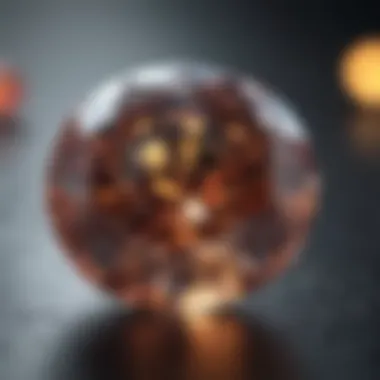
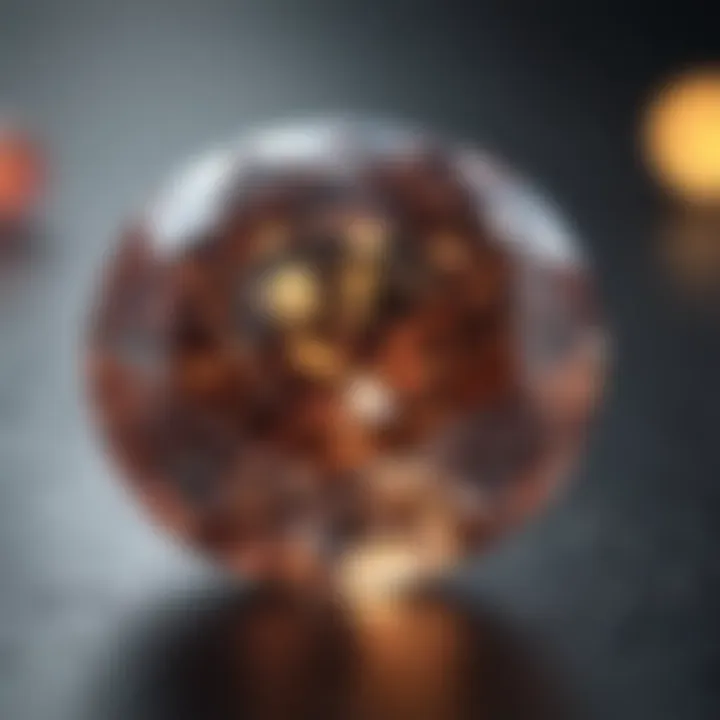
Intro
The realm of gemstones has always sparked intrigue and admiration. Among these, diamonds hold a singular position not just as an accessory but as a symbol of wealth, power, and commitment. To fully appreciate the complexities associated with diamond pricing, one must first understand the core aspects of gemstones themselves. This section delves into the essence of gemstones, their classification, and the historical dimensions that have shaped their significance.
Gemstone Overview
Definition of Gemstones
Gemstones are naturally occurring materials, often prized for their beauty, rarity, and durability. These stones undergo minimal alteration, usually through cutting and polishing, to enhance their aesthetic value. Diamonds, specifically, are formed deep within the Earth under intense pressure and heat, composed of carbon atoms arranged in a crystal lattice structure. This unique formation gives diamonds their renowned hardness and brilliance.
Classification of Gemstones
Gemstones generally fall into two categories: precious and semi-precious.
- Precious Gemstones: These include diamonds, rubies, sapphires, and emeralds. They are typically rare, and their allure is heightened by cultural significance and historical background.
- Semi-Precious Gemstones: While they may be beautiful, stones like amethyst, aquamarine, and garnet are more abundant and hence, less valuable compared to their precious counterparts.
The classification not only affects their market demand but also dictates how certain gems are perceived culturally, which ultimately influences pricing trends.
Historical Significance
Origins of Gemstone Use
Humans have engaged with gemstones for thousands of years. The earliest records point to their use in ancient societies where they served multiple purposes - from adornments in religious ceremonies to tools for trade. Diamonds gained particular esteem in the 1400s when they began to be cut and polish, establishing their reputation as a luxurious item among Europe's elite.
Cultural Insights: Gemstones in Ancient Civilizations
Across civilizations, gemstones have been revered for symbolic meanings:
- Egyptians: Believed that turquoise offered protection and good fortune.
- Greeks and Romans: Associated amethyst with sobriety and safety while diamonds symbolized courage and invincibility.
- Indians: Created astrological connections with stones, considering them powerful talismans influencing their fortunes and destinies.
These cultural insights highlight how the perception of gemstones has evolved, ultimately impacting their market presence and pricing trends.
"Nothing sparkles like a diamond, and its historical significance is as bright as its shine."
Looking ahead, this exploration of diamond price trends will incorporate a keen analysis of market conditions, consumer habits, and various regional implications that influence today’s values, providing a roadmap for investors and enthusiasts alike.
Prolusion to Diamond Pricing
The diamond market is a fascinating realm, filled with its unique set of intricacies and idiosyncrasies. Understanding diamond pricing is not just an academic exercise; it has real-world implications for consumers, investors, and enthusiasts alike. This section aims to lay the groundwork for a comprehensive examination of how diamonds are priced, highlighting the factors that drive price variations and their relevance in today's marketplace.
Crucially, the diamond pricing mechanism reflects a confluence of various influences. Market forces, emotional attachments, cultural significance, and even economic conditions all play a crucial role. The notion that diamonds are forever ties them to important life events, making their pricing fluctuance deeply interconnected with societal trends.
Understanding the Diamond Market
To truly grasp diamond pricing, one must first understand the broader diamond market landscape. It's a multi-faceted domain, where each diamond's value can be attributed to a plethora of characteristics, including:
- Carat Weight: Larger diamonds often carry a premium due to their rarity.
- Color and Clarity: The degree of colorlessness and internal flaws significantly affect a stone's appeal.
- Cut Quality: A well-cut diamond will reflect light beautifully, elevating its desirability.
Moreover, the diamond industry operates in a somewhat opaque manner, dominated by a few large players, such as De Beers and Alrosa. These companies influence the market not just through their production but also through their marketing strategies which can sway public perception and demand. Consequently, fluctuations in supply, whether from political turmoil in diamond-producing regions or investment trends in natural vs. lab-created diamonds, can create ripples that reverberate throughout the entire market.
Importance of Price Fluctuations
Price fluctuations in the diamond market may seem trivial at first glance, but they carry significant implications. For investors, understanding these price trends aids in making informed decisions about when to buy or sell. Even for consumers purchasing engagement rings or heirloom pieces, awareness of pricing trends can be beneficial.
"A dip in price may signal a good buying opportunity for consumers, while rising prices could signal an investment potential for seasoned buyers."
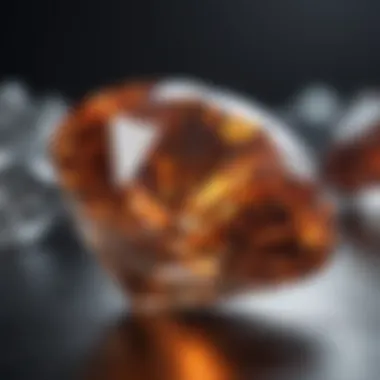
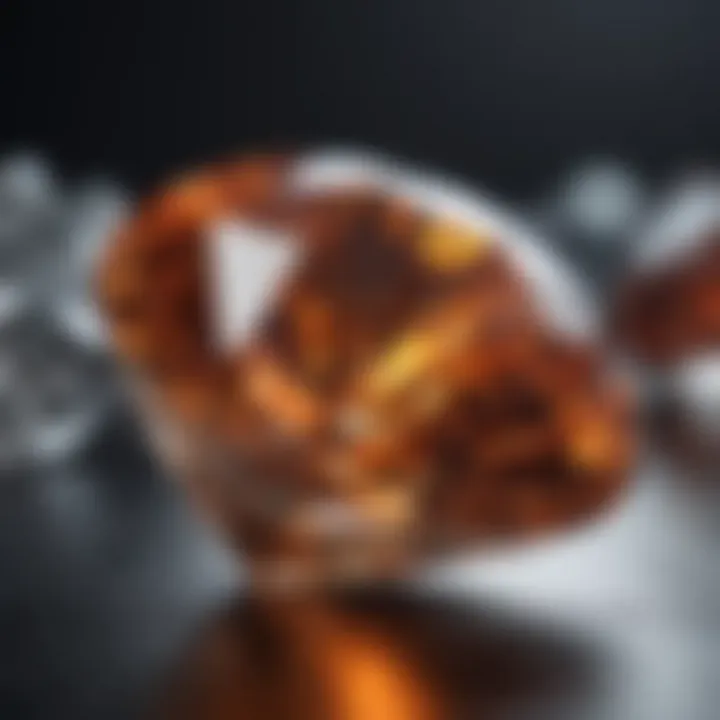
In addition, various seasonal and economic factors often influence these price changes. For instance, the holiday season typically sees an increase in sales, thus pushing prices higher. Similarly, economic downturns may lead to reduced discretionary spending, which can drive prices down. A nuanced understanding of these fluctuations allows stakeholders to navigate the market with greater confidence.
In essence, the foundation for a deeper understanding of diamond pricing lies in recognizing the broader forces at play within the diamond market, emphasizing that price is not just a number, but a reflection of much more. This intricate interplay of factors sets the stage for a detailed exploration of historical context, current trends, and future expectations to come.
Historical Context of Diamond Prices
Understanding the historical context of diamond prices is pivotal for anyone looking to grasp the nuances of today’s diamond market. The value of diamonds is not just derived from their physical beauty or rarity, but also from the intricate tapestry of events, trends, and shifts in consumer behavior that have shaped their pricing over the years. By exploring the past, one can shed light on how external factors have influenced diamond valuations and how the cyclical nature of the market may offer insights into future trends.
Price Trends Over the Decades
Over the decades, diamond prices have waltzed through various trends, influenced by a medley of social, economic, and even technological factors. While one often thinks of diamonds as eternally valuable, the reality is more complex. For example, in the 1980s, diamonds saw a significant boom driven by aggressive marketing strategies and a growing demand for engagement rings. The "A Diamond is Forever" campaign stood as a catalyst for this trend, embedding the notion of diamonds in romantic narratives.
However, the early 2000s showed a stark downturn, coinciding with the burst of the dot-com bubble. Prices dipped, and the market was flooded with synthetic options. Here, it became apparent that diamonds, while traditionally viewed as safe investments, could also be swayed by market volatility and shifting consumer preferences.
- 1980s Boom: Aggressive marketing increased consumer engagement and demand.
- 2000s Dip: Economic downturns shifted consumer focus and brought synthetics into the fold.
- 2010s Rebound: A resurgence in luxury spending and the rise of online marketplaces provided a new stage for diamonds to flourish again.
As noted, while diamonds hold an intrinsic allure, external forces dictate their market positioning. Investing in diamonds requires an understanding of these historical price ebbs and flows, allowing potential buyers to make informed decisions.
Impact of Major Events on Pricing
Major global events have often steered diamond prices in unexpected directions. The significance of these events cannot be overstated; they operate as echoes in the diamond timeline, influencing consumer sentiment and market dynamics. The 2008 financial crisis is a pertinent case in point. The economic downturn led to a radical shift in consumer spending, particularly on luxury goods like diamonds. Many chose to forego large purchases, leading to a temporary price plummet.
Conversely, geopolitical tensions may drive prices upwards. For instance, during times of conflict in diamond-mining regions, supply constraints can tighten considerably, inflating the perceived value of existing stock. Additionally, the introduction of newer technologies and sustainable practices have also played a role.
Major events that have shaped diamond prices include:
- 2008 Financial Crisis: Led to a decline in luxury spending and diamond prices.
- Geopolitical Tensions: Mining conflicts affecting supply chains, driving prices higher.
- Technological Advances: Innovations such as synthetic diamond production affecting market perception and price stability.
"The diamond market reflects not just beauty, but also the shifting sands of humanity’s economic and social patterns. Understanding these patterns is key for any investor or aficionado."
Therefore, anyone delving into the diamond market should perceive it not just as a static landscape, but as a vibrant ecosystem that grows and evolves, shaped by both historical legacies and modern-day events.
Current Market Overview
Understanding the current market for diamonds is like trying to read the signs on a shifting highway. With a dynamic array of factors at play, including economic conditions and consumer shopping behaviors, the diamond market can change in the blink of an eye. This section provides much-needed clarity, spotlighting how these elements work together and affect investor decisions. A well-rounded view on the current marketplace not only helps potential buyers make informed choices but also assists seasoned collectors in understanding where the wind is blowing in their investments.
Recent Price Movements
When it comes to diamonds, price movements act as a barometer of market sentiment. Trends can vary significantly. For instance, the past few years have shown fluctuations that reflect broader economic conditions. In 2020, during the pandemic, many experienced a downturn. Business closures and travel restrictions led to reduced demand. However, the market began to rebound in 2021, with demand surging as couples delayed engagements were suddenly rushing in a wedding frenzy.
Among the critical factors influencing these price shifts are:
- Global economic recovery: As economies stabilize, luxury goods, including diamonds, gain traction.
- Supply constraints: Natural occurrences, such as mine closures or geopolitical conflicts, can tighten supply chains, driving prices upwards.
- Consumer behavior: Shifts in preferences, such as favoring sustainable or lab-grown diamonds, also affect pricing dynamics.
Recent price data shows that while some higher-quality diamonds are fetching prices reminiscent of pre-pandemic levels, there's a noticeable divergence. For example, specific color or clarity characteristics can command considerably higher prices, while others languish.
"Navigating the diamond market is akin to walking on a tightrope; one wrong move and the gains can evaporate."
Comparative Analysis of Different Diamonds
Diving deeper into the diamond pool, not all stones are created equal. Different types of diamonds exist, and understanding their pricing is crucial for buyers and investors alike. How do we wade through the options?
- Natural Diamonds: These beauties are formed under the Earth’s pressure over millions of years. Their unique charcteristics can cause variance in pricing. Premiums are often paid for those with exceptional clarity and carat weight.
- Lab-Grown Diamonds: Recent advancements in technology have made these alternatives not only more accessible but also socially conscious. As the stigma around lab-grown diamonds diminishes, their prices remain lower than their natural counterparts, making them appealing for budget-minded buyers.
- Fancy Colored Diamonds: A category that can often defy typical market trends. Colors like pink, blue, and yellow diamonds are often rarer and, in many cases, more expensive. They can serve as prospective investments, often outperforming traditional diamonds.
When comparing different diamonds in a market that seems as fickle as the wind, it is wise to keep the unique characteristics in mind. Not just any diamond will do; one must consider the type, quality, and the ever-evolving consumer trends.
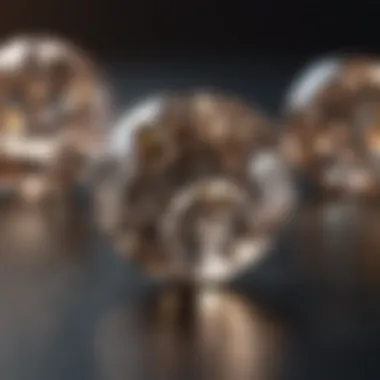
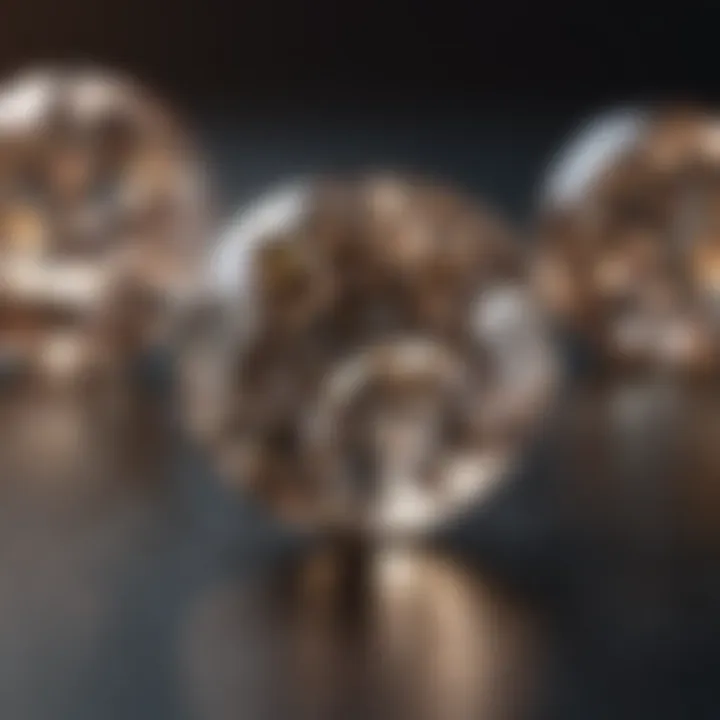
In summary, the current market overview illuminates how various influences shape the pricing of diamonds today.
Key Factors Influencing Diamond Prices
Understanding diamond prices requires digging into various elements that shape their value. This section delves into three key factors: supply chain considerations, consumer demand dynamics, and economic factors at play. Each of these aspects plays a vital role in determining the market price of diamonds, and lacks consideration can result in misunderstandings about the market.
Supply Chain Considerations
The supply chain is crucial when it comes to diamond pricing. The journey of a diamond begins far beneath the Earth’s surface, and from there, it travels through multiple stages before reaching consumers. Each stage in this journey can affect the final price. For instance:
- Exploration and Mining: Mining diamonds is not just about extraction; it involves significant investment in technology, labor, and environmental management. Given the limited number of active mines, disruptions in mining can lead to scarcity.
- Cutting and Polishing: Once mined, diamonds are sent to cutters who skillfully shape and polish them. The labor involved is skilled and time-intensive, impacting operational costs that ultimately reflect in pricing.
- Distribution: Finally, the diamonds will pass through a web of distributors and wholesalers before reaching retailers. Each step can add layers of cost.
When a particular mine faces closure or when technological advancements improve efficiency, these shifts resonate throughout the entire supply chain, affecting the overall pricing structure.
Consumer Demand Dynamics
The consumer's appetite for diamonds also shapes their market prices significantly. As society changes, so do preferences; this flexibility can lead diamonds to either soar or plummet in value. Factors include:
- Cultural Significance: In some cultures, diamonds are considered essential for symbolizing love, especially in engagement rings. This creates sustained and high demand.
- Fashion Trends: The rise of alternative lifestyles and minimalist trends can influence preferences. For instance, a spike in interest in lab-created diamonds—often more affordable and ethically sourced—challenges the traditional diamond pricing tiers.
- Promotional Influence: Advertising campaigns by jewelers can sway public perception and drive demand. When society views diamonds as must-have items, prices tend to rise.
It's fascinating how shifts in consumer trends impact demand and, subsequently, pricing. As long as individuals cherish the allure of diamonds, their demand—and therefore their prices—will remain in constant flux.
Economic Factors at Play
The diamond market is no island; it reacts to broader economic currents. Understanding the economic climate is fundamental for any studious investor or enthusiast.
- Global Economic Conditions: Economic health fluctuates globally, affecting disposable income. In booms, luxury purchases like diamonds increase, while downturns can lead consumers to tighten their belts.
- Currency Strength: Diamonds are traded globally, often in U.S. dollars. When the dollar strengthens against other currencies, it can make diamonds more expensive for international buyers, potentially lowering demand.
- Investment Trends: Diamonds are increasingly viewed as alternative investments. When stock markets become volatile, some may look towards high-value diamonds for safer investments, driving up prices across the board.
“Understanding these economic factors is pivotal for discerning the future of diamond pricing. It’s as much about perception as it is about the actual market.”
Regional Variations in Pricing
Understanding how diamond prices fluctuate across various regions is crucial for several reasons. First, it allows investors to make informed decisions about where to buy and sell diamonds. Regions can have differing demand and supply dynamics, affecting pricing. Furthermore, it highlights the diverse cultural attitudes towards diamonds, which further influences their perceived value. For anyone involved in the diamond market, grasping these variations provides a strategic edge.
Market Differences: US vs. International
When comparing the diamond market in the United States to that of other nations, notable disparities emerge. In the US, diamonds are often marketed as symbols of love and commitment, particularly in the case of engagement rings. This cultural significance drives a robust demand, particularly for high-quality stones. On the contrary, in regions like India or parts of the Middle East, diamonds are considered more of an investment or a status symbol.
- Pricing Structures: In the US, retail markups can be quite hefty due to marketing and branding, while international markets may have lower markups due to less advertising expense.
- Quality Preferences: American consumers often prioritize quality and certification, as seen with stones graded by GIA or AGS. In contrast, some international buyers might focus more on the size of the stone rather than its cut or clarity.
Another intriguing aspect is the rise of synthetic diamonds. In the US, the market for these stones is growing but still faces stigma. Meanwhile, countries like China embrace lab-grown diamonds, viewing them as eco-friendly options.
Cultural Influences on Value Perception
The perception of value when it comes to diamonds is not solely dictated by market forces; cultural context plays a vital role. In cultures where diamonds dominate wedding traditions, prices can skyrocket. For example, in South Asia, especially India, diamonds are often part of wedding dowries. The emotional weight attached to these stones can inflate their value beyond what market forces would suggest.
"Diamonds are priced not only on the four Cs (cut, clarity, color, carat) but also on the cultural significance attached to them in different parts of the world."
- Demand vs. Supply: In some areas, the emotional connection to diamonds creates a higher willingness to pay, while in others, diamonds might be seen as mere commodities.
- Regional Celebrations and Traditions: Certain festivals or celebrations can spike diamond purchases. For instance, during the Diwali festival in India, buying diamonds as gifts can increase demand significantly.
Each market tells its own story in the diamond trade, illuminating how deeply intertwined culture and pricing truly are. By appreciating these nuances, stakeholders can navigate the complex web of diamond pricing with greater insight.
Investment Perspectives
In examining diamond price trends, the Investment Perspectives section plays a crucial role. It's here that we shift our focus from merely appreciating the gemstones' beauty to understanding their value potential as a tangible asset. Diamonds are often viewed as luxury items, yet they hold significance much deeper than that. This section will unpack why they may be an appealing choice for investors and collectors alike, presenting a multifaceted view to aid decision-making.

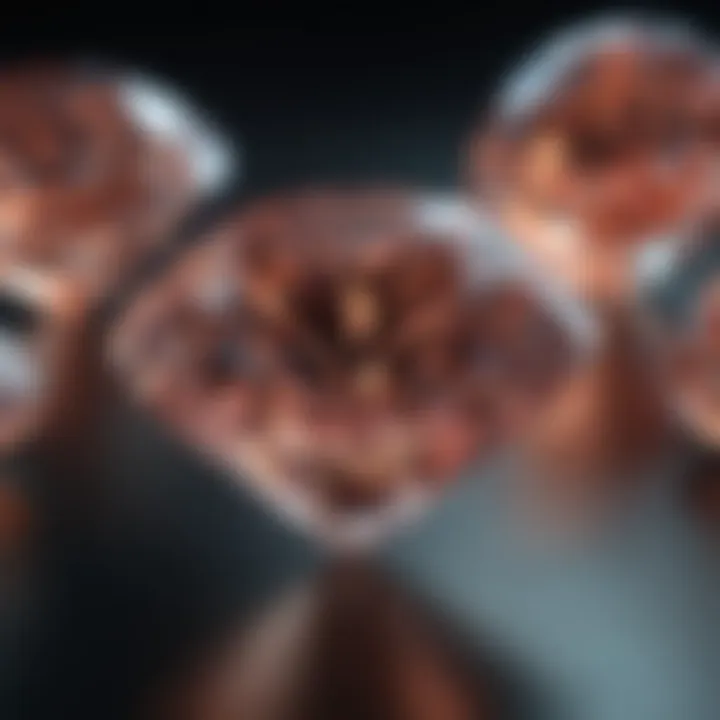
Diamonds as an Asset Class
When it comes to investing, diamonds are unique and complex. Unlike stocks or bonds, diamonds are largely illiquid, meaning you can’t easily convert them back to cash. However, their scarcity and enduring demand make them a compelling asset class for certain investors.
Key factors to consider include:
- Intrinsic Value: Diamonds possess a value that tends to hold or even appreciate over time due to their rarity.
- Portfolio Diversification: Including diamonds in an investment portfolio can reduce risk. They often move independently of stocks or bonds, which can alleviate market volatility impacts.
- Emotional Appeal: Beyond financial aspects, diamonds carry emotional weight for many. This makes them not just investments but also heirlooms and expressions of sentiment.
- Demand Dynamics: The demand for diamonds, particularly high-quality stones, remains solid, affected by cultural attitudes and market trends.
Investors looking into diamonds should understand the Four Cs—cut, clarity, color, and carat weight—which influence a diamond's market value. Collecting diamonds not just for their intrinsic beauty but also for investment showcases a savvy understanding of asset diversification.
Risk and Return Considerations
Investing in diamonds isn’t without its challenges. Several risks should be kept in mind:
- Illiquidity: Unlike stocks you can sell at the drop of a hat, diamonds may take time to find a buyer willing to pay the price you expect.
- Market Fluctuations: The diamond market can fluctuate based on economic conditions, consumer trends, and even geopolitical factors, which can affect valuations.
- Subjectivity of Value: Unlike owning a stock in a company, the value of diamonds can be quite subjective. A buyer's emotional connection or preference may significantly alter what a stone is worth.
- Storage and Insurance Costs: High-quality diamonds can require significant investment in secure storage and insurance, adding to overall costs.
Despite these challenges, many investors find diamonds rewarding. The limited supply and the potential for high appreciation rates, particularly for rare stones, can create lucrative opportunities.
In summary, while diamonds can serve as a worthwhile investment option, it’s essential to approach purchasing with due diligence, informed perspectives, and an understanding of both risks and potential rewards. For those ready to delve into this fascinating market, diamonds offer an asset class ripe with opportunity.
Future Outlook for Diamond Prices
Understanding the future of diamond prices is crucial for investors and enthusiasts alike. The diamond market, often perceived as static, has been undergoing subtle shifts influenced by various global factors. As we look ahead, it's essential to dissect trends and innovations that shape this valuable industry. This section will explore both emerging patterns in consumer behavior and the anticipated growth trajectory of the diamond market.
Emerging Trends and Innovations
The diamond market is no longer just about natural stones. In recent years, lab-grown diamonds have made a significant impact, bringing about a paradigm shift in pricing dynamics. These stones, often cheaper than their mined counterparts by up to 30%, are gaining popularity among younger consumers who prioritize ethical sourcing and cost-effectiveness.
Key Factors Driving the Shift:
- Sustainability Concerns: Many consumers are becoming increasingly aware of the environmental impact of diamond mining. Lab-grown alternatives offer a more eco-friendly option, appealing to environmentally conscious buyers.
- Technological Advances: Innovations in growing diamonds in laboratories have improved both the quality and market perception of these products. The advancements mean that lab-grown diamonds can now match the brilliance and clarity of natural ones, making them a compelling choice.
- Changing Preferences: Millennials and Gen Z are redefining luxury. They place significance on personal values over tradition, influencing market perceptions. The trends suggest that authenticity and purpose are now key drivers of purchase decisions.
"The shift towards lab-grown diamonds reflects a broader trend of ethical consumerism in luxury markets."
These evolving dynamics suggest an intriguing future for diamond pricing. As the market adapts to these innovations, we can expect fluctuations in demand that will undoubtedly influence pricing structures.
Projected Market Growth
Looking at projections, the diamond industry is set for notable growth, albeit with a few caveats. According to various market analyses, the global diamond market is projected to reach around $97 billion by 2027, driven primarily by increasing demand in emerging markets and the continuing appeal of luxury goods.
Important Considerations:
- Emerging Markets: Countries such as India and China are witnessing a surge in middle-class consumers who view diamonds as a marker of status and wealth. This shift may create new opportunities and challenges in traditional diamond markets.
- E-commerce Growth: Online retailing is expected to transform how diamonds are sold. Consumers are increasingly comfortable buying high-value items online, a trend accelerated by the pandemic.
- Consumer Education: As more people learn about diamonds, there's a potential for increasing demand for quality and specific characteristics, affecting pricing. As the saying goes, knowledge is power—and in this case, it translates into consumer behavior that could reshape market expectations.
Looking forward, investors must keep an eye on not only the prices but also the market sentiment as it evolves in response to these trends. Staying informed about technological innovations and changing consumer preferences will be crucial for anyone looking to navigate the complexities of diamond investments.
End and Key Takeaways
Analyzing diamond price trends provides invaluable insights into a market that is often perceived as complex and opaque. Understanding the ebb and flow of diamond prices is not just beneficial for those in the gemstone trade but for anyone intrigued by the interplay between market forces and consumer behavior. The nuances of diamond pricing ultimately reflect broader economic themes and regional peculiarities, which makes grasping these trends imperative for collectors and investors alike.
Summarizing Key Insights
Throughout this article, we've traversed the multifaceted world of diamond pricing. Here are some of the key insights derived from our exploration:
- Market Dynamics: Prices fluctuate based on supply chain factors and consumer demand. When one examines the extensive networks that bring diamonds from mines to markets, it's clear that disruptions can spark notable price changes.
- Regional Discrepancies: The diamond market doesn't operate uniformly across the globe. Differences in culture, market maturity, and economic conditions can lead to significant variances in pricing. For instance, diamonds in the North American market may command different prices compared to those sold in European or Asian markets.
- Historical Context Matters: Understanding historical price movements allows investors to spot potential future trends. We discussed how global events, from economic downturns to social shifts, can profoundly affect perceptions of value.
- Investment Viability: Recognizing diamonds as an emerging asset class introduces exciting prospects for investment. The historical appreciation in value and emotional significance further enhance their allure.
"In an oftentimes volatile market, the only sure bet is informed decision-making."
Final Thoughts on Value Understanding
As collectors and enthusiasts dive deeper into this domain, they must remain vigilant about market trends and indicators. Whether one is looking to purchase a diamond for personal satisfaction or as an investment, informed choices are key to maximizing value. In a world where diamonds are more than mere stones, understanding their market is about understanding the very essence of desire and worth.



